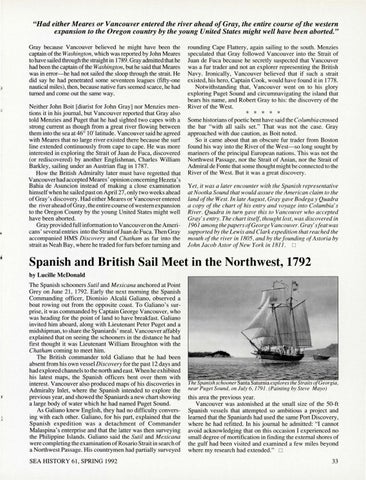"Had either Meares or Vancouver entered the river ahead of Gray, the entire course of the western expansion to the Oregon country by the young United States might well have been aborted." Gray because Vancouver believed he might have been the captain of the Washington, which was reported by John Meares to have sailed through the straight in 1789. Gray admitted that he had been the captain of the Washing ton, but he said that Meares was in error-he had not sailed the sloop through the strait. He did say he had penetrated some seventeen leagues (fifty-one nautical miles), then, because native furs seemed scarce, he had turned and come out the same way. Neither John Boit [diarist for John Gray] nor Menzies mentions it in his journal, but Vancouver reported that Gray also told Menzies and Puget that he had sighted two capes with a strong current as though from a great river flowing between them into the sea at46° 10' latitude. Vancouver said he agreed with Meares that no large river existed there because the surf line extended continuously from cape to cape. He was more interested in exploring the Strait of Juan de Fuca, discovered (or rediscovered) by another Englishman, Charles William Barkley, sailing under an Austrian flag in 1787. How the British Admiralty later must have regretted that Vancouver had accepted Meares' opinion concerning Hezeta' s Bahia de Asuncion instead of making a close examination himself when he sailed past on April 27, only two weeks ahead of Gray's discovery. Had either Meares or Vancouver entered the river ahead of Gray, the entire course of western expansion to the Oregon County by the young United States might well have been aborted. Gray provided full information to Vancouveron the Americans' several entries into the Strait of Juan de Fuca. Then Gray accompanied HMS Discovery and Chatham as far into the strait as Neah Bay, where he traded for furs before turning and
rounding Cape Flattery, again sailing to the south. Menzies speculated that Gray followed Vancouver into the Strait of Juan de Fuca because he secretly suspected that Vancouver was a fur trader and not an explorer representing the British Navy. Ironically, Vancouver believed that if such a strait existed, his hero, Captain Cook, would have found it in 1778. Notwithstanding that, Vancouver went on to hi s glory exploring Puget Sound and circumnavigating the island that bears his name, and Robert Gray to his: the discovery of the River of the West.
* * * * *
Some historians of poetic bent have said the Columbia crossed the bar "with all sails set." That was not the case. Gray approached with due caution, as Boit noted. So it came about that an obscure fur trader from Boston found his way into the River of the West-so long sought by mariners of the principal European nations. This was not the Northwest Passage, nor the Strait of Anian, nor the Strait of Admiral de Fonte that some thought might be connected to the River of the West. But it was a great discovery. Yet, it was a later encounter with the Spanish representative at Nootka Sound that would assure the American claim to the land of the West. In late August, Gray gave Bodega y Quadra a copy of the chart of his entry and voyage into Columbia's River. Quadra in turn gave this to Vancouver who accepted Gray's entry. The chart itself, thought lost, was discovered in 1961 among the papers ofGeorge Vancouver. Gray' sfeat was supported by the Lewis and Clark expedition that reached the mouth of the river in 1805 , and hy the founding of Astoria by John Jacob Astor of New York in 181 1. 0
Spanish and British Sail Meet in the Northwest, 1792 by Lucille McDonald
f
The Spanish schooners Sutil and Mexicana anchored at Point Grey on June 21, 1792. Early the next morning the Spanish Commanding officer, Dionisio Alcala Galiano, observed a boat rowing out from the opposite coast. To Galiano 's surprise, it was commanded by Captain George Vancouver, who was heading for the point of land to have breakfast. Galiano invited him aboard, along with Lieutenant Peter Puget and a midshipman, to share the Spaniards' meal. Vancouver affably explained that on seeing the schooners in the distance he had first thought it was Lieutenant William Broughton with the Chatham coming to meet him. The British commander told Galiano that he had been absent from his own vessel Discovery for the past 12 days and had explored channels to the north and east. When he exhibited his latest maps, the Spanish officers bent over them with interest. Vancouver also produced maps of his discoveries in Admiralty Inlet, where the Spanish intended to explore the previous year, and showed the Spaniards a new chart showing a large body of water which he had named Puget Sound. As Galiano knew English, they had no difficulty conversing with each other. Galiano, for his part, explained that the Spanish expedition was a detachment of Commander Malaspina's enterprise and that the latter was then surveying the Philippine Islands. Galiano said the Sutil and Mexicana were completing the examination of Rosario Strait in search of a Northwest Passage. His countrymen had partially surveyed SEA HISTORY 61, SPRING 1992
The Spanish schooner Santa Satumia explores the Straits ofGeorgia, near Puget Sound, on July 6, 1791. (Painting by Steve Mayo)
this area the previous year. Vancouver was astonished at the small size of the 50-ft Spanish vessels that attempted so ambitious a project and learned that the Spaniards had used the same Port Discovery, where he had refitted. In his journal he admitted: "I cannot avoid acknowledging that on this occasion I experienced no small degree of mortification in finding the external shores of the gulf had been visited and examined a few miles beyond where my research had extended." D
33
